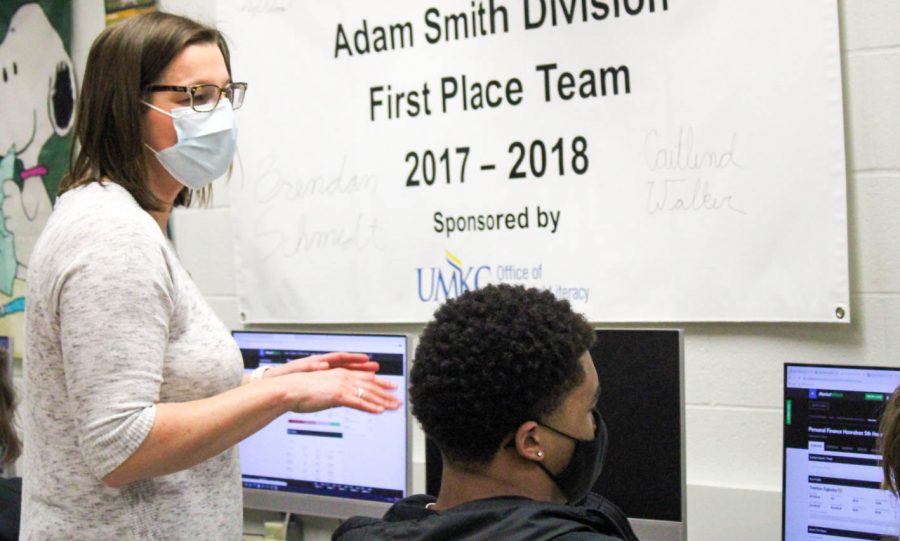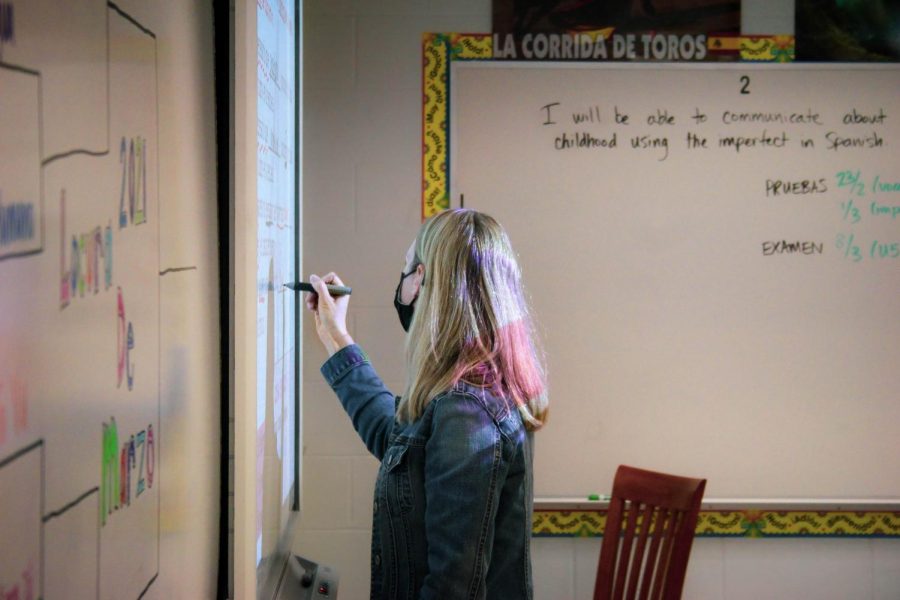Your donation will support the student journalists of Francis Howell North High School. Your contribution will allow us to purchase equipment and cover our annual website hosting costs.
The Budget Cuts are the Product of Multiple Failed Tax Levies
Although the present financial situation of the district appears grim, those who observe the district’s budget have seen the writing on the wall for a long time. Ever since the failure of multiple tax levies, the district’s finances have been on the brink of requiring drastic measures, such as teacher cuts.
“A tax levy is a major funding mechanism used in the state of Missouri to fund political subdivisions of the state, like school districts,” Kevin Supple, Chief Operating Officer of FHSD for the last 16 years, said. “Taxes are levied on all real and personal property in the district. The funds are collected by the county and distributed to the local districts based on their individual tax rates.”
In other words, a tax levy is an increase on property taxes that goes to fund the school district. Property tax accounts for the single largest source of income for the district, making roughly 55 percent of the FHSD budget. The school board and the district administration must work together in order to propose a tax levy, which is then voted on by the county’s constituents.
“The school board directs the superintendent and the executive board to look at the finances of the district,” board member and former educator Patrick Lane said. “Then they ask them to propose a tax levy that would be a certain amount to generate funds for the school.”
Even after not passing a levy, the district was able to keep most of its faculty intact, only making soft cuts on vacant positions not filled up until now. However, the COVID-19 pandemic put a massive strain on the district’s finances, pushing it over the brink.
“Hindsight is always great,” board member and former nurse for the district Janet Stiglich said. “I do agree that [a tax levy] would be helping us now, but who would’ve thought back in 2018 we would have COVID here and how much that would’ve taken a hit on our budget. As much as I’d like to say yes, I do agree definitely we would be in a better position, but I still do believe we would be making some cuts.”
Despite the setbacks caused by COVID-19 and the volatile state of the district’s budget, there is still hope to recover and move forward. A tax levy can serve as a lifeline to the district, providing it with much needed money in order to prevent staff cuts from happening again. Furthermore, a levy can also provide the funding needed to modernize and improve the district and learning experience of students. DesThe success of students remains the utmost priority of the board and district.
“You have to invest in your future,” Lane said. “Our children are our future, and I want the kids in my neighborhood to grow up and be someone. And how can we do that? We have to offer our children one of the best educations that we can around. You cannot do that on a limited dollar.”
How the District Budget Cuts Will Affect the Present
With the district’s fall in allotted money, teaching positions are one of the first things to go. The reduction in faculty will result in a loss of teachers throughout the entire district, but the loss will be heavy in all three FHSD high schools.
“Because of COVID-19, state tax revenue has gone down significantly,” head principal Nathanael Hostetler said. “There’s a huge reduction in consumer spending, a huge reduction in taxes, so the state disbursements have dropped off significantly. In the last two fiscal years, the district has lost $10 million in state revenue, and the economy continues to struggle. It’s created a very real pinch.”
As with many of the budgeting decisions, part of the decision will come from a district level and some from the school’s individual administration. The district’s job is to decide how many teaching positions will be lost; it’s FHN’s decision on who specifically gets cut. The district, however, was able to save a few teacher positions from being cut using one-time care money.
“We found out the positions [being cut], the teachers spoke with us, and we decided to use our care money to shore up and protect those positions for one more year,” Board of Education member Patrick Lane said.
The decision was made on a need-basis. As counselors figure out class sizes for next year, administration plans to cut teachers who don’t have enough students to fill classes. This could mean teachers will take on larger class sizes than they have in the past, and there may be a shift in who teaches what course. Some courses may not be offered because of newfound staffing limits.
One exception to cutting classes are the required courses, such as classes that students need to graduate, like personal finance, or core classes where students take End-of-Course (EOC) exams.
“What we would anticipate is an increase in the average number of students in each classroom, so in that sense, it will impact students,” Hostetler said. “If we lose a significant number of teachers, there’s a possibility of erasing some classes since we won’t be able to offer them. There are going to be some classes where there’s not a lot of wiggle room, and some where there are.”
Department Heads Worry about the Effects of the Budget Cuts
This upcoming school year, FHSD will be experiencing budget cuts that will affect FHN and various departments. For FHN departments, this could range anywhere from job cuts to cuts in materials and supplies. But a few years ago, the FHSD Board of Education was not in a position to make budget cuts.
“In the last three years (since she’s been on the school board), we have not passed a tax levy however we had given our teachers a raise the first year I was on the Board,” FHSD Board of Education Vice President Janet Stiglich said. “And the next year we gave them another raise of 1.5% knowing that our budget would be taking a hit due to the fact that we knew we were giving raises without a tax levy.”
Due to the blow the economy took because of COVID-19, the combination of a nonexistent tax levy and the money spent on raises, it left the district budget in tatters.
“After COVID hit, the economy kind of tanked and we lost a lot of our funding from the state,” Stiglich said. “We had already committed to these salaries and the bottom line was we had to have a balanced budget and we had to make cuts in order to make that happen.”
With these potential cuts looming over the upcoming school year, department heads are gearing up to face the worst.
“It’s hard to explain to the community why Francis Howell North is getting a brand new, state of the art high school and we might possibly not have the proper staff and classes will sit empty and that’s a very hard thing,” Business Department head Melissa Hanrahan said. “I also think that our Board of Education, if they knew this was happening, they could’ve come back to teachers and asked them to take a percentage cut.”
In fact, according to Spanish teacher Anelise Mossinghoff teachers were not consulted when the cuts were being decided. But for Hanrahan, the concern lies not only in the cuts being made, but in future class sizes. Too many students in a class can pose a problem for teachers as they will have a more difficult time focusing on each individual student. And of those departments often overlooked is the PE Department.
“If we’re going to be experiencing cuts, we’d lose at least part of a position,” PE Department head Kim Martin said. “Obviously, it’s huge anytime you lose any member of your department and for us if we do lose someone, that’s going to limit the options students have to take for electives in PE.”
The Budget Cuts Will Have Lasting Effects on the District
As the end of the school year draws closer, the prospect of budget cuts becomes more of a reality. Starting July 1, the effects of the cutting of teachers and budgets from various parts of the district will start to be felt. While the budget cuts are not nearly as bad as initially thought, the impact is not lessened and this leaves many wondering what the future of the district will look like. One of the biggest cuts the district made is the cut of roughly 52 certified teaching staff in the district.
“I don’t think any one of us walked in and said to them to start cutting teachers,” FHSD Board of Education Vice President Janet Stiglich said. “That didn’t happen. We asked our administrative team to start looking at ways that we could save the district some money.”
One perspective that can be looked at is that of a new teacher. When a new teacher is hired, they may be hired under a 1 year contract, meaning they only have a job for one year unless the contract is renewed. However as this year is nearing complete, so are many of the contracts of those in this position. Teachers like these are some of the first to be considered for cuts as opposed to older, more experienced teachers.
On March 1, Governor Mike Parsons released over $280 million of the revenue restrictions. This money is going to be used to help fund many different departments, including education throughout the state. Roughly $700,000 of this money will go towards funding of virtual schools and education programs. That being said, the money being released is not projected to have a large impact on the cuts within FHSD.
“I can tell you that the release of the funds by the Governor was welcome news,” FHSD’s Chief Operating Officer, Kevin Supple, said in a statement about the funding from the governor. “However, I built the budget based on full funding of the formula. The release of the funds means that we will come close to meeting our budget, but it is not a source of uncommitted funds that we could use. Also, the released funds are the state’s general revenue portion of the formula funding. Part of our formula funding comes from gaming proceeds (e.g., lottery) and that revenue source continues to underperform expectations. As such, even with the release of the general revenue funds, the formula may still not be fully funded this year.”
While the budget reduction means fewer teachers, it also means larger class sizes for next year. While the increase of class sizes is inevitable, the classes are not going to increase by nearly as much according to Head Principal Nathanael Hostetler. The class average now is 23.5 students and is set to be around 24.5 students after the cuts.
“It’s going to feel fuller,” Hostetler said. “But the classes are still capped. We’ve got sort of a soft cap at 28 [students] and a hard cap at 30 [students] and that hasn’t changed. So when Dr. Greer and I sit down and look at those numbers, if we have classes that are going over 30 then we will just add more sections and that redistributes it.”
While the cuts are going to affect class sizes, Stiglich and Lane both confirmed that no extracurriculars or activities directors will be cut as of now. These include people like sports coaches, club sponsors, and other extracurricular leaders.
The future doesn’t look nearly as grim as originally prospected. While the cuts are not as bad they will still have lasting impacts on the district. (Tayler Ross contributed to this story)






